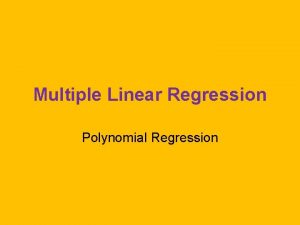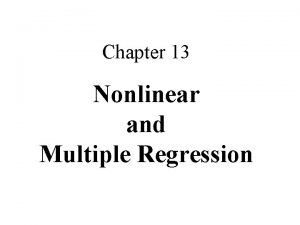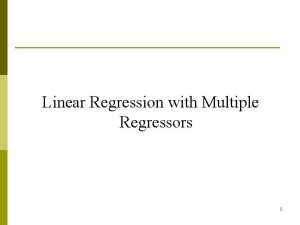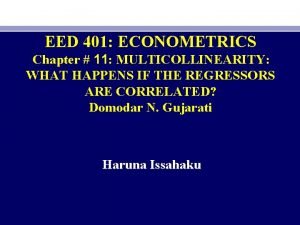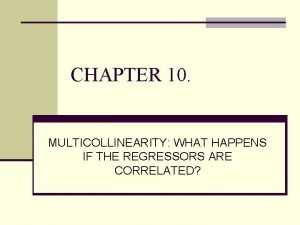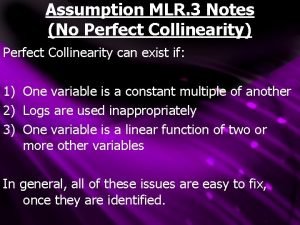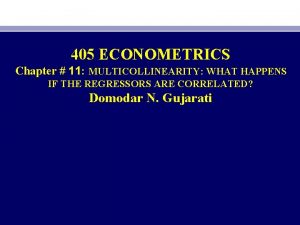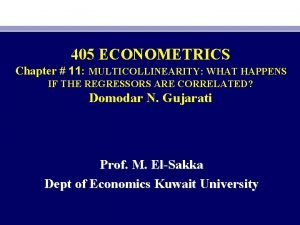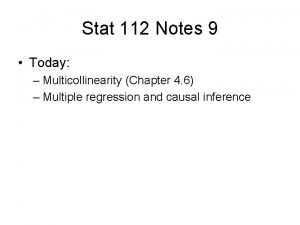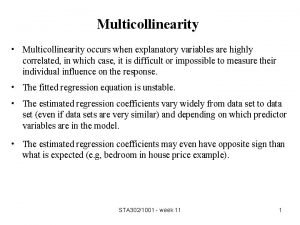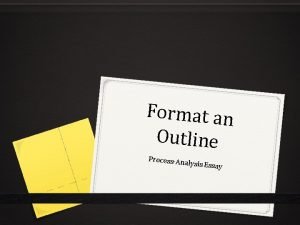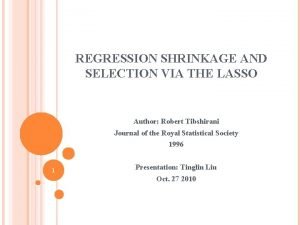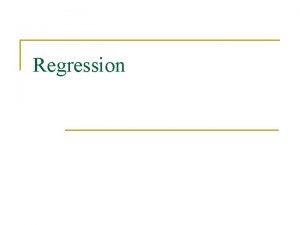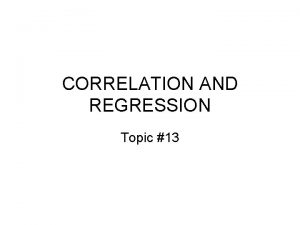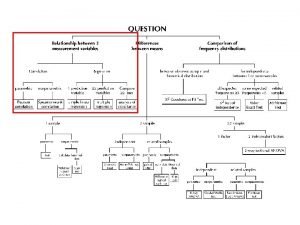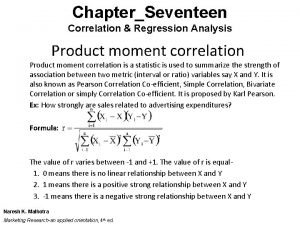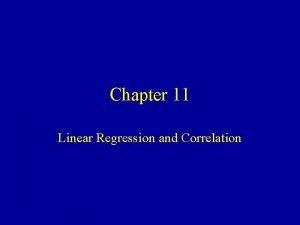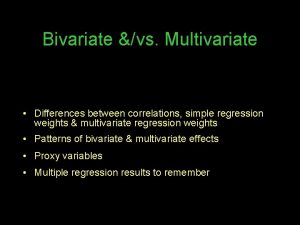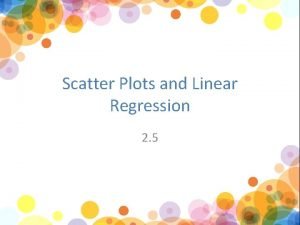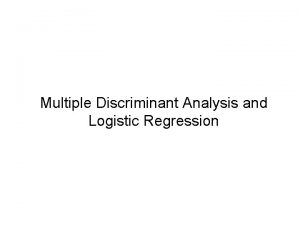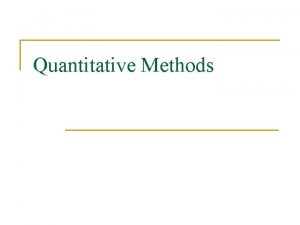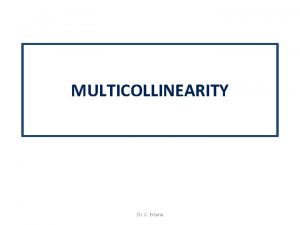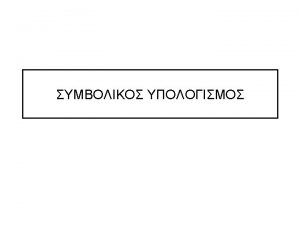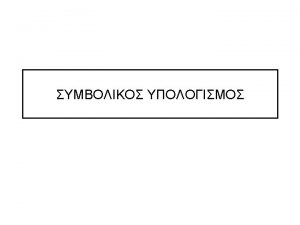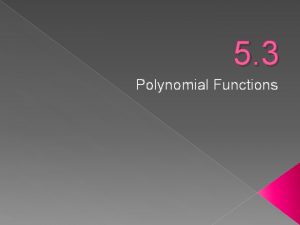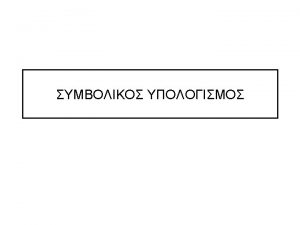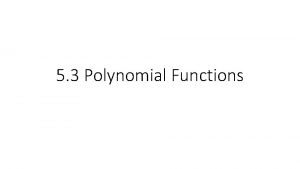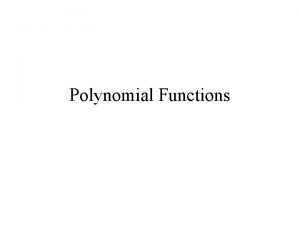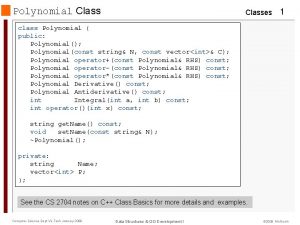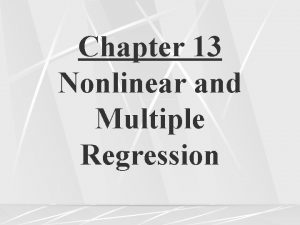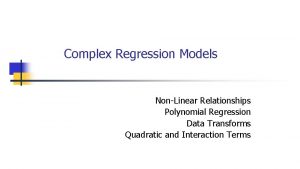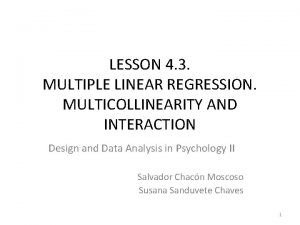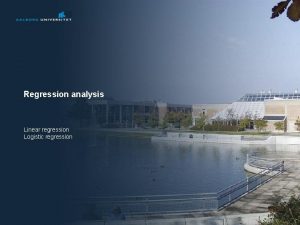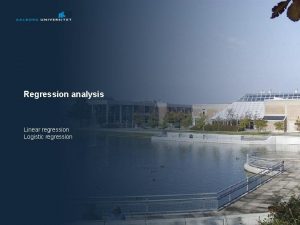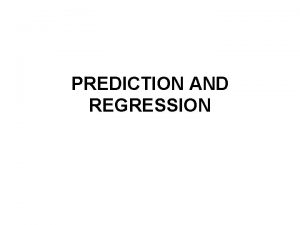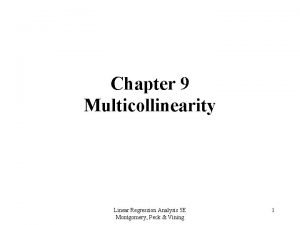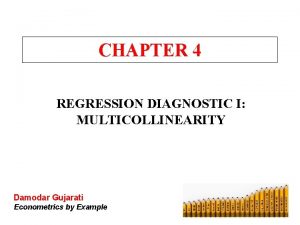Topic 16 Multicollinearity and Polynomial Regression Outline Multicollinearity





































- Slides: 37

Topic 16: Multicollinearity and Polynomial Regression

Outline • Multicollinearity • Polynomial regression

An example (KNNL p 256) • The P-value for ANOVA F-test is <. 0001 • The P values for the individual regression coefficients are 0. 1699, 0. 2849, and 0. 1896 • None of these are near our standard significance level of 0. 05 • What is the explanation? Multicollinearity!!!

Multicollinearity • Numerical analysis problem in that the matrix X΄X is close to singular and is therefore difficult to invert accurately • Statistical problem in that there is too much correlation among the explanatory variables and it is therefore difficult to determine the regression coefficients

Multicollinearity • Solve the statistical problem and the numerical problem will also be solved – We want to refine a model that currently has redundancy in the explanatory variables – Do this regardless if X΄X can be inverted without difficulty

Multicollinearity • Extreme cases can help us understand the problems caused by multicollinearity – Assume columns in X matrix were uncorrelated • Type I and Type II SS will be the same • The contribution of each explanatory variable to the model is the same whether or not the other explanatory variables are in the model

Multicollinearity – Suppose a linear combination of the explanatory variables is a constant • Example: X 1 = X 2 → X 1 -X 2 = 0 • Example: 3 X 1 -X 2 = 5 • Example: SAT total = SATV + SATM • The Type II SS for the X’s involved will all be zero

An example: Part I Data a 1; infile ‘. . /data/csdata. dat'; input id gpa hsm hss hse satm satv genderm 1; Data a 1; set a 1; hs = (hsm+hse+hss)/3; Proc reg data=a 1; model gpa= hsm hss hse hs; run;

Output Analysis of Variance Source Model Sum of Mean DF Squares Square F Value Pr > F 3 27. 71233 9. 23744 18. 86 <. 0001 Error 220 107. 75046 0. 48977 Corrected Total 223 135. 46279 • Something is wrong • df. M=3 but there are 4 X’s

Output NOTE: Model is not full rank. Least-squares solutions for the parameters are not unique. Some statistics will be misleading. A reported DF of 0 or B means that the estimate is biased.

Output NOTE: The following parameters have been set to 0, since the variables are a linear combination of other variables as shown. hs = 0. 33333*hsm + 0. 33333*hss + 0. 33333*hse

Output Parameter Estimates Parameter Standard Variable DF Estimate Error t Value Pr > |t| Type I SS Type II SS Intercept 1 0. 58988 0. 29424 2. 00 0. 0462 1555. 5459 1. 96837 hsm B 0. 16857 0. 03549 4. 75 <. 0001 25. 80989 11. 04779 hss B 0. 03432 0. 03756 0. 91 0. 3619 1. 23708 0. 40884 hse B 0. 04510 0. 03870 1. 17 0. 2451 0. 66536 hs 0 0 . . . In this extreme case, SAS does not consider hs in the model

Extent of multicollinearity • This example had one explanatory variable equal to a linear combination of other explanatory variables • This is the most extreme case of multicollinearity and is detected by statistical software because (X΄X) does not have an inverse • We are concerned with cases less extreme

An example: Part II *add a little noise to break up perfect linear association; Data a 1; set a 1; hs 1 = hs + normal(612)*. 05; Proc reg data=a 1; model gpa= hsm hss hse hs 1; run;

Output Analysis of Variance Source Model Sum of Mean DF Squares Square F Value Pr > F 4 27. 81586 6. 95396 14. 15 <. 0001 Error 219 107. 64693 0. 49154 Corrected Total 223 135. 46279 Model seems to be good here

Output Parameter Estimates Variable Intercept Parameter Standard DF Estimate Error t Value Pr > |t| Type I SS Type II SS 1 0. 56271 0. 30066 1. 87 0. 0626 1555. 5459 1. 72182 hsm 1 0. 02411 0. 31677 0. 08 0. 9394 25. 80989 0. 00285 hss 1 -0. 11093 0. 31872 -0. 35 0. 7281 1. 23708 0. 05954 hse 1 -0. 10038 0. 31937 -0. 31 0. 7536 0. 66536 0. 04856 hs 1 1 0. 43805 0. 95451 0. 46 0. 6467 0. 10352 • None of the predictors significant. • Look at the differences in Type I and II sums of squares • Sign of the coefficients?

Effects of multicollinearity • Regression coefficients are not well estimated and may be meaningless • Similarly for standard errors of these estimates • Type I SS and Type II SS will differ • R 2 and predicted values are usually ok

Pairwise Correlations • Pairwise correlations can be used to check for “pairwise” collinearity • Recall KNNL p 256 proc reg data=a 1 corr; model fat=skinfold thigh midarm; model midarm = skinfold thigh; run;

Pairwise Correlations • Cor(skinfold, thigh)=0. 9238 • Cor(skinfold, midarm) = 0. 4578 • Cor(thigh, midarm) = 0. 0847 • Cor(midarm, skinfold+thigh) = 0. 9952!!! • See p 284 for change in coeff values of skinfold and thigh depending on what variables are in the model

Polynomial regression • We can fit a quadratic, cubic, etc. relationship by defining squares, cubes, etc. , of a single X in a data step and using them as additional explanatory variables • We can do this with more than one explanatory variable if needed • Issue: When we do this we generally create a multicollinearity problem

KNNL Example p 300 • Response variable is the life (in cycles) of a power cell • Explanatory variables are – Charge rate (3 levels) – Temperature (3 levels) • This is a designed experiment

Input and check the data Data a 1; infile ‘. . /data/ch 08 ta 01. txt'; input cycles chrate temp; run; Proc print data=a 1; run;

Output Obs 1 2 3 4 5 6 7 8 9 10 11 cycles 150 86 49 288 157 131 184 109 279 235 224 chrate 0. 6 1. 0 1. 4 temp 10 10 10 20 20 20 30 30 30

Create new variables and run the regression Data a 1; set a 1; chrate 2=chrate*chrate; temp 2=temp*temp; ct=chrate*temp; Proc reg data=a 1; model cycles= chrate temp chrate 2 temp 2 ct; run;

Output Source Model Error Corrected Total Analysis of Variance Sum of Mean DF Squares Square F Value Pr > F 5 55366 11073 10. 57 0. 0109 5 5240. 4386 1048. 0877 10 60606

Output Parameter Estimates Variable Intercept chrate temp chrate 2 temp 2 ct DF 1 1 1 Parameter Estimate 337. 72149 -539. 51754 8. 91711 171. 21711 -0. 10605 2. 87500 Standard Error t Value Pr > |t| 149. 96163 2. 25 0. 0741 268. 86033 -2. 01 0. 1011 9. 18249 0. 97 0. 3761 127. 12550 1. 35 0. 2359 0. 20340 -0. 52 0. 6244 4. 04677 0. 71 0. 5092

Conclusion • Overall F significant, individual t’s not significant → multicollinearity problem • Look at the correlations (proc corr) • There are some very high correlations – r(chrate, chrate 2) = 0. 99103 – r(temp, temp 2) = 0. 98609 • Correlation between powers of a variable

A remedy • We can remove the correlation between explanatory variables and their powers by centering • Centering means that you subtract off the mean before squaring etc. • KNNL rescaled by standardizing (subtract the mean and divide by the standard deviation) but subtracting the mean is key here

A remedy • Use Proc Standard to center the explanatory variables • Recompute the squares, cubes, etc. , using the centered variables • Rerun the regression analysis

Proc standard Data a 2; set a 1; schrate=chrate; stemp=temp; keep cycles schrate stemp; Proc standard data=a 2 out=a 3 mean=0 std=1; var schrate stemp; Proc print data=a 3; run;

Output Obs 1 2 3 4 5 6 7 8 9 10 11 cycles 150 86 49 288 157 131 184 109 279 235 224 schrate -1. 29099 0. 00000 1. 29099 -1. 29099 0. 00000 1. 29099 stemp -1. 29099 0. 00000 1. 29099

Recompute squares and cross product Data a 3; set a 3; schrate 2=schrate*schrate; stemp 2=stemp*stemp; sct=schrate*stemp;

Rerun regression Proc reg data=a 3; model cycles=schrate stemp schrate 2 stemp 2 sct; run;

Output Analysis of Variance Source Model Error Corrected Total DF 5 Sum of Squares 55366 Mean Square F Value Pr > F 11073 10. 57 0. 0109 5 5240. 4386 1048. 0877 10 60606 Exact same ANOVA table as before

Output Parameter Estimates Variable Intercept Parameter Standard DF Estimate Error t Value Pr > |t| 1 162. 84211 16. 60761 9. 81 0. 0002 schrate 1 -43. 24831 10. 23762 -4. 22 0. 0083 stemp 1 58. 48205 10. 23762 5. 71 0. 0023 schrate 2 1 16. 43684 12. 20405 1. 35 0. 2359 stemp 2 1 -6. 36316 12. 20405 -0. 52 0. 6244 sct 1 6. 90000 9. 71225 0. 71 0. 5092

Conclusion • Overall F significant • Individual t’s significant for chrate and temp • Appears linear model will suffice • Could do formal general linear test to assess this. (P-value is 0. 5527)

Last slide • We went over KNNL 7. 6 and 8. 1. • We used programs Topic 16. sas to generate the output for today
 How to make a sandwich paragraph
How to make a sandwich paragraph Linear regression vs multiple regression
Linear regression vs multiple regression Linear model regression
Linear model regression Survival analysis vs logistic regression
Survival analysis vs logistic regression Logistic regression vs linear regression
Logistic regression vs linear regression Polynomial regression spss
Polynomial regression spss Nonlinear regression lecture notes
Nonlinear regression lecture notes Polynomial regression
Polynomial regression Multicollinearity problems
Multicollinearity problems Regressors meaning
Regressors meaning Perfect multicollinearity
Perfect multicollinearity Ballentine view of multicollinearity
Ballentine view of multicollinearity Mlr 4
Mlr 4 Ballentine view of multicollinearity
Ballentine view of multicollinearity Ballentine view of multicollinearity
Ballentine view of multicollinearity Consequences of multicollinearity
Consequences of multicollinearity Multicollinearity occurs when
Multicollinearity occurs when Paragraph writing strategies
Paragraph writing strategies Narrow
Narrow Matplotlib inline
Matplotlib inline How to divide a polynomial by another polynomial
How to divide a polynomial by another polynomial How to start topic sentence
How to start topic sentence A topic outline uses
A topic outline uses Long essay question
Long essay question Outline example
Outline example Digital topic outline
Digital topic outline Regression shrinkage and selection via the lasso.
Regression shrinkage and selection via the lasso. Difference between regression and correlation
Difference between regression and correlation Correlation and regression
Correlation and regression Difference between regression and correlation
Difference between regression and correlation Classification and regression trees (cart)
Classification and regression trees (cart) Difference between regression and correlation
Difference between regression and correlation Trendlines and regression analysis
Trendlines and regression analysis Coefficient of determination formula in regression
Coefficient of determination formula in regression Difference between correlation and regression
Difference between correlation and regression Bivariate vs multivariate
Bivariate vs multivariate 2-5 scatter plots and lines of regression
2-5 scatter plots and lines of regression Logistic regression and discriminant analysis
Logistic regression and discriminant analysis





